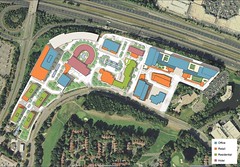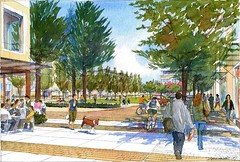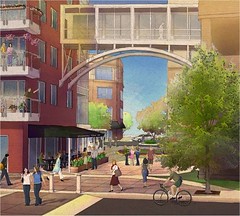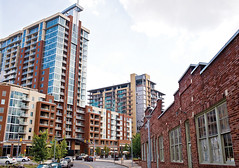The new LEED-ND standards: what’s new, what’s good, and what’s not (part 2)

Posted May 8, 2009 at 1:20PM
As I wrote yesterday, the LEED for Neighborhood Development partnership (US Green Building Council, Congress for the New Urbanism, and NRDC, representing the smart growth community) has published a fully revised set of standards for public comment. Comments will be accepted online up until June 14, and I hope those of you who follow these issues will take advantage of the opportunity.
 Yesterday, I presented a summary of where we are in the process and of the standards in the "smart location and linkages" section. That, in my opinion, is the section with the most relevance to neighborhood environmental performance and the one that I know best. Today, I'll be discussing the neighborhood pattern and design section.
Yesterday, I presented a summary of where we are in the process and of the standards in the "smart location and linkages" section. That, in my opinion, is the section with the most relevance to neighborhood environmental performance and the one that I know best. Today, I'll be discussing the neighborhood pattern and design section.
As before, all the images accompanying this post are from projects certified under the LEED-ND pilot. OK, here goes:
The "NPD" prerequisites
The neighborhood pattern and design category contains three prerequisites, and they weren't changed much from the previous draft. The revisions to the language, although frequent, speak mostly to technical issues and precision.
There is one exception, though, which affects how density is calculated for the compact development prerequisite ("NPDp2"); it is a bit hidden, in the definition of "buildable land." This is a seriously wonky issue, but the bottom line is that the revised definition makes the density requirements a bit easier to achieve if the development contains preserved land.
 The environment primarily cares about "gross" density - the size of the regional footprint, compared to how many people, jobs, and buildings it contains; the smaller the better. But, in fairness to developers, we did not want to count land against their density achievement if it was not available for development under law or other prerequisites of LEED-ND. Land that was voluntarily set aside by the developer still counted in the density formula under the previous language.
The environment primarily cares about "gross" density - the size of the regional footprint, compared to how many people, jobs, and buildings it contains; the smaller the better. But, in fairness to developers, we did not want to count land against their density achievement if it was not available for development under law or other prerequisites of LEED-ND. Land that was voluntarily set aside by the developer still counted in the density formula under the previous language.
The new draft allows an additional limited exception for certain categories of voluntarily preserved land, up to 15 percent of the total land in the development. I believe it is a reasonable compromise that rewards the creation of permanent neighborhood open space without allowing so much that it hinders the intent of LEED-ND to keep overall development compact. The applicant may set aside more land than the 15 percent, of course, but for the project to be certified as smart and green s/he must compensate with enough density elsewhere so that the overall average meets the program's minimum.
The compact development prerequisite also retains the requirement that projects with frequent transit service meet a higher density threshold. I've always been a bit ambivalent about that, since it penalizes transit-served projects and favors those without. The counter-argument has been that we want to support transit with ridership where it exists.
The walkable streets prerequisite ("NPDp1") adds a new requirement that no more than 20 percent of street frontages may be occupied by garages. I think that is a good change. Other aspects of this standard are refined but not really changed.  If it were solely my system, I don't know that I would mandate that buildings have a minimum height (given that the development must already meet a minimum density), but in the spirit of compromise I'm fine with it and I strongly agree with the requirements for sidewalks and building entrances on the street.
If it were solely my system, I don't know that I would mandate that buildings have a minimum height (given that the development must already meet a minimum density), but in the spirit of compromise I'm fine with it and I strongly agree with the requirements for sidewalks and building entrances on the street.
The minor change in the connected and open community prerequisite ("NPDp3") lowering the threshold for internal project street connectivity from 150 to 140 intersections per square mile is fine. Without getting into the details, the proponents made a good case for it in committee.
My main issue with the NPD prerequisites is that I think there should be two more of them. Since comments on the LEED-ND draft must be made issue-by-issue, I'll get into those when I discuss the credits they relate to.
The "NPD" credits
I think the best way to handle these is with bullet points:
- NPDc1 - walkable streets: This credit provides up to a whopping 12 points for compliance with criteria from a menu of highly prescriptive design standards. I don't agree with all of it (which is not to say that I don't agree with the importance of walkable streets), but these details were really important to the new urbanist architects on the committee.
- NPDc2 - compact development: There is not much change from the previous draft, although the credit, like the corresponding prerequisite, is affected by the change to the definition of "buildable land," as discussed above.
 This credit only gets half the points that NPDc1 gets, environmental research notwithstanding.
This credit only gets half the points that NPDc1 gets, environmental research notwithstanding. - NPDc3 - mixed use: This is another very important issue, so much so that I would make compliance with a baseline mixed-use standard a prerequisite for smart and green certification. Separation of land uses from each other has been a major problem with sprawl, and I just don't believe that a neighborhood can be considered "smart growth" if it does not contain diverse functions, either supplied by the developer or pre-existing nearby. We actually had a mixed-use prerequisite in an early draft of the standards, but it was so weak as to be not worth retaining. I wish we had improved it instead of deleting it.
- In addition, there is one change to the mixed-use credit in the new draft that, frankly, I do not remember discussing in committee and that I think is a mistake: The standard allows planned uses outside the project's control to count as if they were real in earning credit. There is no definition of "planned" and no guarantee whatever that they will actually be realized. This is wishful thinking, not a meaningful standard.
- NPDc4 - mixed-income, diverse communities: Affordability is another community element that I believe so important to smart growth that it should have a prerequisite in the system. A requirement that certified developments contain some affordable units was proposed, but it was voted down. The primary argument against the requirement was that weak-market cities, such as those in the Rust Belt, are so in need of urban development of any kind (and what they already have is per se affordable) that it would be counterproductive to burden any new development there with requirements. I am not unsympathetic to that point, but think we should have tried harder to fashion a requirement for affordability in the places where it is most needed.
- Beyond whether there should be a prerequisite for affordability, the new draft lowers the thresholds for earning points under this credit. On its face, that is a bit troublesome. I went along with it in committee because I have a great deal of trust in the committee member who proposed it and whom I know to be passionately committed to affordability. I hope thoughtful people will comment on it in this round.
- NPDc9 - civic and open spaces: My main problem with this standard, and it is not new, is that we give no credit specifically for parks; we treat hardscape the same as we treat green space.
 I think that may have originally appealed to committee members who did not want to disfavor highly urban locations. But I have since come to believe that those are the ones most in need of greenery, and I believe we should have crafted an incentive (perhaps by shifting a point from NPDc1 here) specifically for neighborhood parks.
I think that may have originally appealed to committee members who did not want to disfavor highly urban locations. But I have since come to believe that those are the ones most in need of greenery, and I believe we should have crafted an incentive (perhaps by shifting a point from NPDc1 here) specifically for neighborhood parks. - NPDc11 - visitability and universal design: This credit has been totally rewritten, pursuant to discussions between a working group of the LEED-ND committee and advocates for people with special needs. I confess that I have not gone into the details of the changes, but I am persuaded that the process the working group followed in crafting them was a healthy one. See if you agree.
- NPDc12 - community outreach and involvement: If this were just my system, instead of one negotiated among competing interests, I would give more points to this credit. I know community engagement can be a lot of work, and that there is a risk that NIMBYs will seek to "dumb down" a smart-growth concept. But I also think there is a bigger set of principles at stake here, having to do with education and community understanding of sustainable development. It is in the interest of those principles that we have as much dialogue as possible. That said, I think the credit has been improved since the last draft, particularly with the awarding of a credit point for projects that receive an endorsement from a local smart-growth rating system. I wonder, though, if we should be requiring more than one public meeting or charrette to earn the points.
- The other NPD credits: In my opinion, the changes to the other credits in this category were minor and in the right direction of improvement.
Issues with the allocation of credit points
Before leaving this category, I have to note that the number of points assigned to some of the credits is, in my opinion, disproportionate to their effect on environmental performance. I like development design more than most people, but there is simply no way that the NPD category should contain 44 points, compared to 27 for the smart location category. Research shows that location has the far greater potential to reduce global warming emissions (see the third graph in my post from last week).
The argument advanced in committee for why the "NPD" category should be granted a larger share of credit points was that development location was granted more protection in the system's prerequisites and thus didn't need as much incentive in the credits.  In the standards used for the pilot program, that was probably true. But, since then, the location prerequisite has been weakened by a much more generous definition of "infill" and by the addition of an option to qualify for adjacent development without transit service. It is not nearly as protective as it once was. Meanwhile, the NPD category's prerequisites were strengthened, by the addition of the walkable streets prerequisite and by the strengthening of the compact development prerequisite for locations near transit. The rationale for the points disparity between these two major categories is simply no longer valid, in my opinion.
In the standards used for the pilot program, that was probably true. But, since then, the location prerequisite has been weakened by a much more generous definition of "infill" and by the addition of an option to qualify for adjacent development without transit service. It is not nearly as protective as it once was. Meanwhile, the NPD category's prerequisites were strengthened, by the addition of the walkable streets prerequisite and by the strengthening of the compact development prerequisite for locations near transit. The rationale for the points disparity between these two major categories is simply no longer valid, in my opinion.
That said, there are some NPD credits that actually deserve more points, and if I were the sole LEED-ND czar I would give more weight to community outreach, visitability, and a new credit for neighborhood parks. I would retain the walkable streets credit but make it more streamlined and with fewer available points. And I would consolidate or eliminate three or four of the other credits. In the real world, or in the committee's version of the real world, it may prove better to leave the points distribution alone rather than go through the painful exercise of renegotiating everything among all the competing interests. But public commenters need not be so pragmatic, and I raise the issue for others to make of it what you will.
Next: the series concludes with a discussion of the green infrastructure and buildings section.